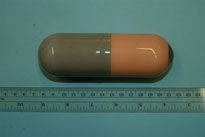Life History Transmitter Tags: LHX1
 The first generation Life History Transmitter or LHX1(right) is an implanted, archival tag that includes a satellite transmitter.
The tag transmits only after it comes out of the host animal’s body once it has died. The LHX1 periodically checks the temperature of the animal.
If it falls much below 37 degrees Celsius (98 degrees Fahrenheit) for Steller sea lions (similar to humans), the tag assumes the animal has died and begins recording a series of temperatures as the body cools. Once the tag records this death (as indicated by the big change in temperature), the tag begins to check if it is immersed in water or surrounded by air. The tag is lighter than water and will float on the surface if the animal has died at sea. If the LHX1 remains in air for a long enough period, it can send its temperature information and location by satellite to the researcher by email. The LHX1 tag is larger than the LHX2 tag and is designed strictly for research in Steller sea lions and other large marine mammals.
The first generation Life History Transmitter or LHX1(right) is an implanted, archival tag that includes a satellite transmitter.
The tag transmits only after it comes out of the host animal’s body once it has died. The LHX1 periodically checks the temperature of the animal.
If it falls much below 37 degrees Celsius (98 degrees Fahrenheit) for Steller sea lions (similar to humans), the tag assumes the animal has died and begins recording a series of temperatures as the body cools. Once the tag records this death (as indicated by the big change in temperature), the tag begins to check if it is immersed in water or surrounded by air. The tag is lighter than water and will float on the surface if the animal has died at sea. If the LHX1 remains in air for a long enough period, it can send its temperature information and location by satellite to the researcher by email. The LHX1 tag is larger than the LHX2 tag and is designed strictly for research in Steller sea lions and other large marine mammals.
To view an interactive CAD drawing of the Life History Transmitter, click here (CAD drawing courtesy of Wildlife Computers).
Specifications:
Size: 42mm (about 1½ inches) in diameter and 125mm (5 inches) long
Weight: 118grams in air (¼ pound) in air
Batteries: Two Lithium Thionyl-chloride primary cells, lifespan greater than 10 years
Transmitter: ARGOS compatible UHF transmitter operating at ½ watt, capable of
approx. 14,000 transmissions after 10 years............
Internal memory: 0.25 MB non-volatile
Sensors Detect:
- Temperature
- Light
- Surrounding medium (air, H20)
- Other specialized sensors
Outer covering: Composite syntactic matrix of resin with micro-glass spheres
Pressure rating: Can withstand a 1,500m water-column depth